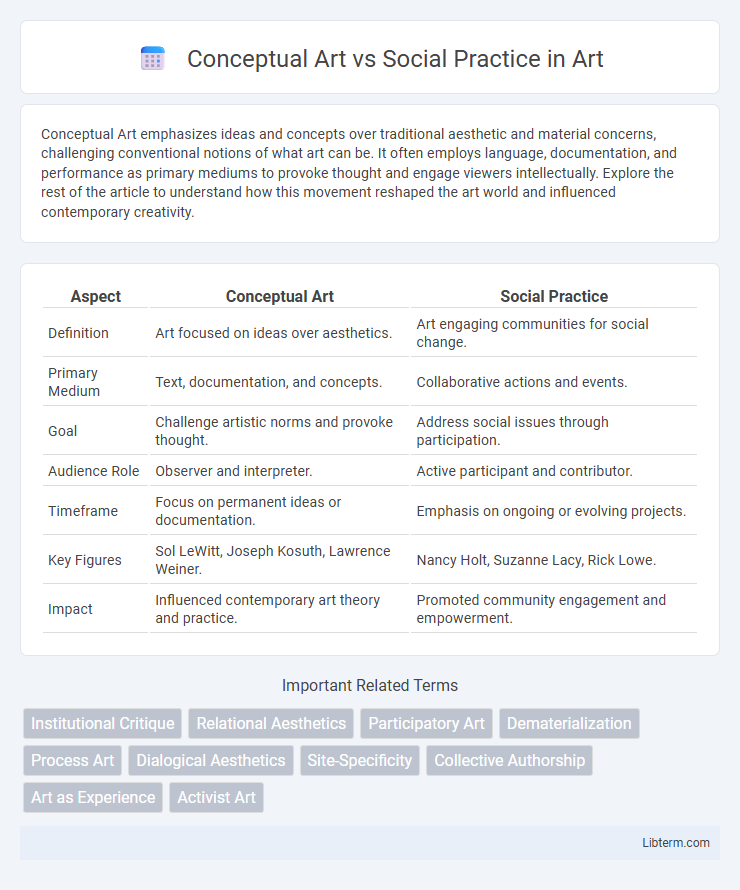Conceptual Art emphasizes ideas and concepts over traditional aesthetic and material concerns, challenging conventional notions of what art can be. It often employs language, documentation, and performance as primary mediums to provoke thought and engage viewers intellectually. Explore the rest of the article to understand how this movement reshaped the art world and influenced contemporary creativity.
Table of Comparison
| Aspect | Conceptual Art | Social Practice |
|---|---|---|
| Definition | Art focused on ideas over aesthetics. | Art engaging communities for social change. |
| Primary Medium | Text, documentation, and concepts. | Collaborative actions and events. |
| Goal | Challenge artistic norms and provoke thought. | Address social issues through participation. |
| Audience Role | Observer and interpreter. | Active participant and contributor. |
| Timeframe | Focus on permanent ideas or documentation. | Emphasis on ongoing or evolving projects. |
| Key Figures | Sol LeWitt, Joseph Kosuth, Lawrence Weiner. | Nancy Holt, Suzanne Lacy, Rick Lowe. |
| Impact | Influenced contemporary art theory and practice. | Promoted community engagement and empowerment. |
Introduction to Conceptual Art and Social Practice
Conceptual Art emphasizes the idea or concept behind the work, prioritizing intellectual engagement over traditional aesthetic concerns, often using text, documentation, and ephemeral materials to challenge conventional art forms. Social Practice centers on collaborative, participatory projects that engage communities and address social issues through interactive and relational experiences, focusing on process and impact rather than material outcomes. Both movements expand the definition of art by shifting attention from physical objects to ideas and social interactions.
Defining the Core Principles
Conceptual Art prioritizes the idea or concept behind the work over traditional aesthetic or material concerns, emphasizing intellectual engagement and often using text or instructions as the artistic medium. Social Practice centers on collaborative, community-driven projects that address social issues and foster participatory experiences, prioritizing process and social interaction over physical art objects. Both approaches challenge conventional art definitions but differ fundamentally in motivation: Conceptual Art foregrounds ideas as art, while Social Practice foregrounds social engagement as artistic action.
Historical Origins and Evolution
Conceptual Art emerged in the 1960s as a movement prioritizing ideas over aesthetic form, rooted in the works of artists like Sol LeWitt and Joseph Kosuth who challenged traditional art objects. Social Practice, evolving later in the 1990s and 2000s, centers on community engagement and collaborative processes, with pioneers such as Suzanne Lacy and Allan Kaprow emphasizing art as social intervention. Both movements reflect shifts in artistic purpose: Conceptual Art critiques art's materiality and authorship, while Social Practice expands art's role in public life and activism.
Key Practitioners and Influential Works
Conceptual Art pioneers like Sol LeWitt and Joseph Kosuth emphasized ideas over aesthetics, with LeWitt's "Wall Drawing #1" showcasing instructions as the art itself, while Kosuth's "One and Three Chairs" deconstructed representation and meaning. Social Practice, driven by artists such as Suzanne Lacy and Theaster Gates, centers on community engagement and social change, exemplified by Lacy's "The Roof Is on Fire" and Gates' revitalization projects in Chicago's South Side. Both movements challenge traditional art boundaries, yet Conceptual Art prioritizes intellectual inquiry, whereas Social Practice focuses on collaborative, socially impactful experiences.
Methods and Techniques Used
Conceptual Art emphasizes the use of text, documentation, and symbolic imagery to convey ideas, often relying on minimal physical artifacts or installations to challenge traditional art forms. Social Practice employs participatory methods, collaborative workshops, and community engagement techniques to foster social interaction and address collective issues. Both approaches prioritize process and meaning over aesthetics but differ in their focus on individual intellectual exploration versus communal involvement.
Role of Audience Participation
Conceptual Art emphasizes the intellectual engagement of the audience, where meaning is often derived through contemplation and the interpretation of ideas presented by the artist. Social Practice, by contrast, relies heavily on active audience participation, fostering community involvement and collaborative experiences that directly influence the artwork's outcome. This shift highlights Social Practice's commitment to social interaction and collective agency, expanding the traditional boundaries of art beyond passive observation.
Societal and Cultural Impact
Conceptual Art challenges traditional aesthetics by prioritizing ideas over visual form, prompting critical reflections on societal norms and individual perception. Social Practice centers on community engagement, using collaborative projects to address social issues and foster cultural dialogue. Both forms significantly influence cultural discourse by redefining art's role from mere object to active participant in societal transformation.
Criticisms and Controversies
Conceptual Art faces criticism for its perceived elitism and lack of accessibility, often being dismissed as overly intellectual or esoteric. In contrast, Social Practice art encounters controversies surrounding authorship, community consent, and the ethical implications of involving marginalized groups. Both movements spark debates over the role of art in society, questioning boundaries between artistic intent and social impact.
Intersection and Divergence of Approaches
Conceptual Art emphasizes the primacy of ideas over aesthetic form, using language, text, and documentation as primary media, while Social Practice centers on community engagement, collaborative processes, and social change through participatory activities. Both approaches intersect in challenging traditional art objects and institutions, prioritizing experience and interaction over commodification. Divergence arises as Conceptual Art often remains within the art world discourse, whereas Social Practice extends into activism and real-world societal impact beyond gallery spaces.
Future Trends in Conceptual Art and Social Practice
Future trends in Conceptual Art emphasize immersive technologies such as virtual and augmented reality to deepen viewer interaction and challenge traditional artistic boundaries. Social Practice continues to evolve by integrating community-driven digital platforms, fostering participatory and inclusive creative processes that address social justice and environmental concerns. Both fields increasingly leverage interdisciplinary collaboration, incorporating AI, data visualization, and blockchain to expand conceptual frameworks and democratize art production and dissemination.
Conceptual Art Infographic

 libterm.com
libterm.com